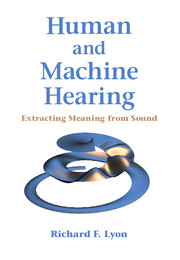Book contents
- Frontmatter
- Dedication
- Contents
- Foreword
- Preface
- Part I Sound Analysis and Representation Overview
- 1 Introduction
- 2 Theories of Hearing
- 3 On Logarithmic and Power-Law Hearing
- 4 Human Hearing Overview
- 5 Acoustic Approaches and Auditory Influence
- Part II Systems Theory for Hearing
- Part III The Auditory Periphery
- Part IV The Auditory Nervous System
- Part V Learning and Applications
- Bibliography
- Author Index
- Subject Index
- Plate section
2 - Theories of Hearing
from Part I - Sound Analysis and Representation Overview
Published online by Cambridge University Press: 28 April 2017
- Frontmatter
- Dedication
- Contents
- Foreword
- Preface
- Part I Sound Analysis and Representation Overview
- 1 Introduction
- 2 Theories of Hearing
- 3 On Logarithmic and Power-Law Hearing
- 4 Human Hearing Overview
- 5 Acoustic Approaches and Auditory Influence
- Part II Systems Theory for Hearing
- Part III The Auditory Periphery
- Part IV The Auditory Nervous System
- Part V Learning and Applications
- Bibliography
- Author Index
- Subject Index
- Plate section
Summary
In respect of the theory of hearing, it seems to me that we need fewer theories and more theorizing. Of theories, focused upon some new finding and seeking to align the entire body of auditory fact with the new principle, we have more than a plenty.
—“Auditory theory with special reference to intensity, volume, and localization,” Edwin G. Boring (1926)The principle of diversity suggests that a simple description of the auditory process may not be possible because the process may not be simple. Theories that appear at first thought to be alternatives may in fact supplement one another.
—“Place mechanisms of auditory frequency analysis,” William H. Huggins and Licklider (1951)Many theories and models have influenced thinking in this field; here we survey some of these, including those modern theories on which we base machine hearing systems.
A “New” Theory of Hearing
Books and papers entitled “A New Theory of Hearing” or something to that effect were once almost commonplace (Rutherford, 1887; Hurst, 1895; Ewald, 1899; Meyer, 1899; Békésy, 1928; Fletcher, 1930; Wever and Bray, 1930b; Wever, 1949). Like many ideas from a few generations back, some of these theories seem a bit quaint from our modern perspective. But in many cases they really did represent some of the most insightful scientific thinking and freshest experimental observations of their times. We review some of these ideas here, emphasizing those that left a lasting mark on our thinking about how hearing works.
Hermann von Helmholtz's Tonempfindungen (Helmholtz, 1863) presented the first major influential theory of hearing. His theory that structures in the cochlea vibrate sympathetically, each place resonating with its own narrow range of frequencies to stimulate a specific nerve, was the foundation for the long-lasting concept of the ear as a frequency analyzer. The arrangement of nerves in the cochlea was associated with individual just-distinguishable tone frequencies, adapting Müller's doctrine of specific nerve energies (Müller, 1838) and applying Fourier's finding that any periodic signal is equal to a sum of sinusoids of harmonically related frequencies (Fourier, 1822).
- Type
- Chapter
- Information
- Human and Machine HearingExtracting Meaning from Sound, pp. 23 - 32Publisher: Cambridge University PressPrint publication year: 2017
- 1
- Cited by



